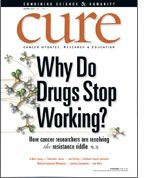Publication
Article
CURE
ASH Updates
Author(s):
Updates from the annual meeting of the American Society of Hematology.
The annual meeting of the American Society of Hematology (ASH) was held in December, bringing thousands of cancer researchers, physicians and industry professionals to New Orleans to report on critical issues in blood cancer treatment, screening, prevention and supportive care.
In previous studies of chronic lymphocytic leukemia (CLL), patients who were relatively healthy were often enrolled over older, sicker patients, despite the fact that the majority of patients with CLL are more than 65 years old and often have other health issues (comorbidities). The CLL11 trial was designed to test newer agents in an older population that better reflects reality. The study included 781 participants with newly diagnosed CLL, a median age of 73 and comorbidities, such as cardiovascular problems, pulmonary disease and diabetes. These patients usually can’t tolerate aggressive chemotherapy, so the CLL11 study compared Leukeran (chlorambucil), an older chemotherapy, against Leukeran with Rituxan (rituximab), a current standard of care, or Leukeran with Gazyva (obinutuzumab), a recently approved therapy for newly diagnosed CLL. Results released this past summer found both combination regimens of Leukeran with the newer agents achieved better responses over Leukeran alone.
Updated results announced at the ASH conference found Gazyva significantly delayed progression-free survival over Rituxan (26.7 months versus 15.2 months). Adding Gazyva also tripled complete responses compared with Rituxan (21 percent versus 7 percent). The most common side effects included low white blood cell counts (neutropenia), infusion-related reactions and low blood platelet counts (thrombocytopenia).
“If we look to the head-to-head comparison, the overall survival data are still immature, however [the data] look quite promising,” says lead investigator Valentin Goede, a clinical scientist at the University Hospital of Cologne in Germany. As a result of these findings, it’s predicted Gazyva may become a standard first-line treatment for elderly patients with comorbidities.
Children who develop acute myeloid leukemia (AML) are typically treated with chemotherapy, but more than half of patients eventually relapse and go on to transplantation or second-line therapy. A phase 3 study shows Mylotarg (gemtuzumab ozogamicin), when given with standard chemotherapy, decreased the risk of relapse, especially in patients who later undergo a transplantation.
Patients in the study were given standard chemotherapy with or without Mylotarg. Those with intermediate-risk disease and a matched related donor or with high-risk disease moved on to transplantation. Patients with low-risk disease or those with intermediate-risk AML without a matched family donor had additional treatment that included chemotherapy with or without Mylotarg. At three years, the high-risk group saw an increase in survival from 49 percent to 68 percent.
Mylotarg was originally approved in 2000 for older patients with relapsed AML, but the drug maker voluntarily withdrew it from the market a decade later based on a lack of effectiveness and safety concerns that emerged in subsequent clinical trials. Based on recent studies in newly diagnosed AML, however, researchers are hopeful the drug can be resurrected and re-examined in this patient population—both young and old.
In one of the largest newly diagnosed myeloma studies to date, the FIRST trial examined 1,623 participants who were randomized to receive one of three treatments: a combination of melphalan, prednisone and Thalomid (thalidomide) (MPT combination) for 12 cycles over the course of 72 weeks, a current standard of care; a combination of Revlimid (lenalidomide) and low-dose dexamethasone (RD) for 18 cycles over the course of 72 weeks; or continuous RD until disease progression. The trial included participants with newly diagnosed multiple myeloma who were either 65 years and older or who were ineligible for a stem cell transplantation. After a median follow-up of about three years, the study showed a favorable benefit for the continuous RD regimen, which reduced the risk of disease progression or death by 28 percent compared with MPT (25.5 months compared with 21.2 months).
The trial data also appears to suggest an overall survival benefit with RD. At the four-year follow-up, 59.4 percent of patients receiving continuous RD were alive compared with 51.4 percent receiving the MPT combination, but the difference is not significant, meaning the improvement in survival could be by chance. Side effects were also significantly less, with fewer incidences of secondary blood cancers, neutropenia and thrombocytopenia. The rate of peripheral neuropathy was also significantly less than with MPT. Due to the increased progression-free survival and fewer toxicities, experts predict that continuous RD will become a new standard of care in patients with newly diagnosed multiple myeloma who are ineligible for transplantation.
Developed to target the anaplastic lymphoma kinase (ALK) mutation, Xalkori (crizotinib) was approved for a subset of nonsmall cell lung cancers. The ALK mutation is also present in more than half of anaplastic large-cell lymphomas. A study looking at the long-term effect of Xalkori in 11 participants with advanced ALK-positive lymphoma showed they experienced a near immediate regression of their disease, with nine participants having a complete response. Although the response was not long-lasting for some, four participants continue to have no signs of disease, and four have successfully gone on to other treatments, including transplantation or an investigational therapy. Subsequent analysis of blood taken from two participants whose disease progressed while on the experimental treatment uncovered new genetic mutations resistant to Xalkori that were not present before treatment.





